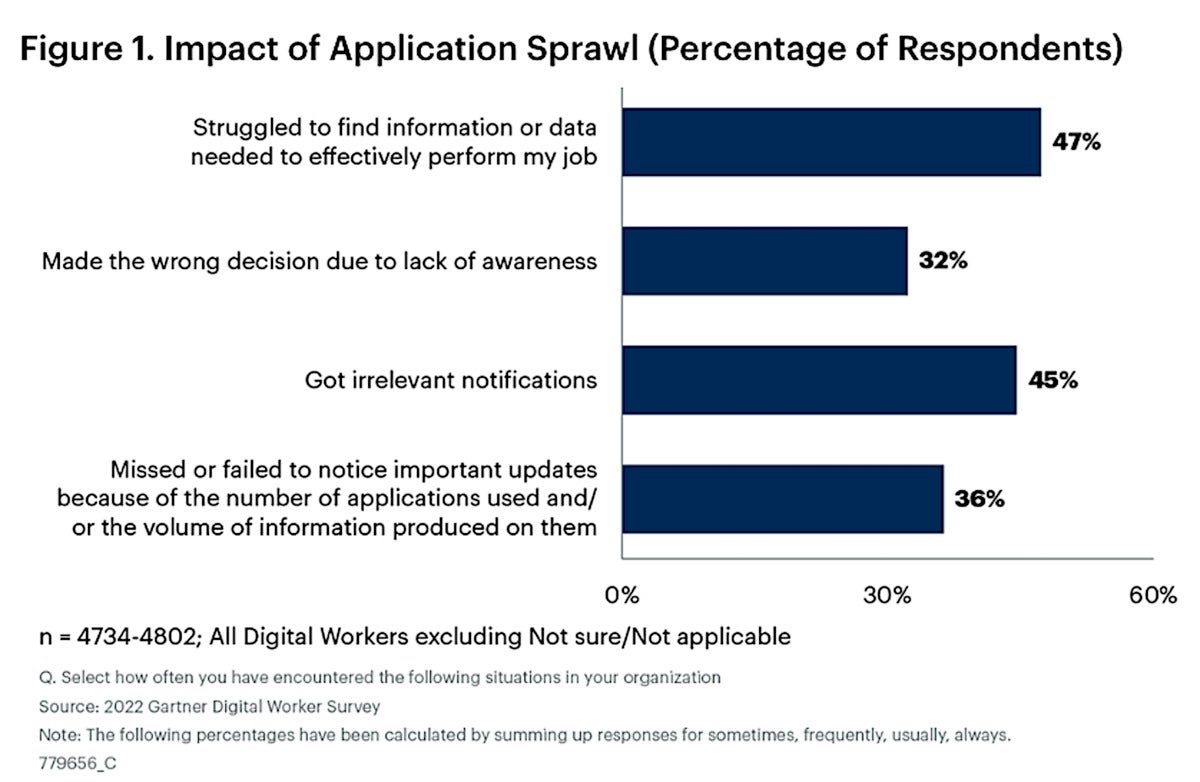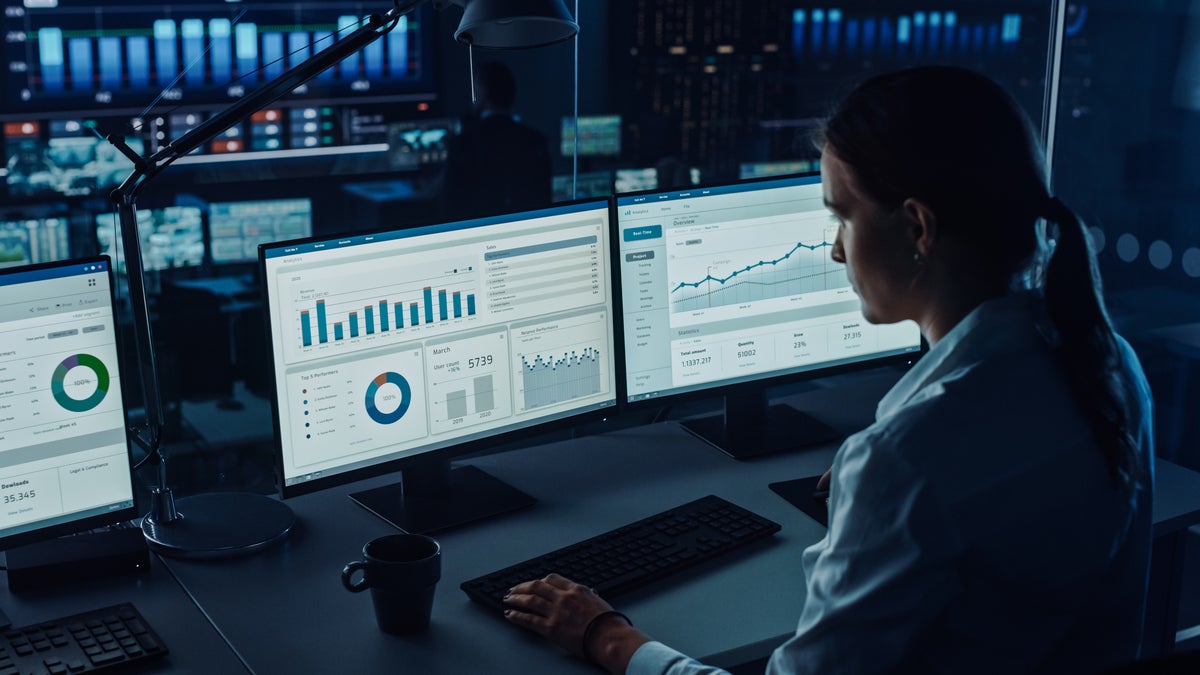































Workers will accept digital tools that monitor them as long as the oversight helps them be more productive, according to a new survey by research firm Gartner.
A whopping 96% of "digital workers" indicated they would be willing to accept electronic monitoring of their online work in exchange for training opportunities or career development (34%); learning more about their job (33%); or gaining proactive help from IT (30%).
Interest in employee productivity monitoring has grown since the COVID-19 pandemic, according to a second Gartner survey released in March.
One big reason workers appear accepting of the use of monitoring software is because they're overwhelmed by the "staggering" amount of information and applications flooding their digital workspaces, according to Gartner.
Knowledge workers, on average now use about 11 applications compared to just six in 2019. Forty percent of digital workers are using more than the average number of applications and 5% use 26 or more applications at work, according to Gartner.
 Gartner
Gartner "Any employee is dealing with digital acceleration, staff departures, having to adjust to various working models, and many more workplace disruptions, and they are exhausted," Daniel Sanchez-Reina, a vice president analyst at Gartner, said in a statement. "When unmanaged, employee fatigue is impacting the success of technological initiatives."
Employee monitoring systems are used to see whether employees are active on devices and in applications, and can be used to determine which employees are most productive and whether business outcomes are being met.
Gartner defines a digital worker as an employee who uses "digital technology," including any combination of devices (laptops, smartphones, and tablets), applications, and web services for communication, information, or productivity. (More recently, the term digital worker has also been used to describe AI-driven chatbots that tackle mundane, repetitive tasks human workers once performed.)
"Although digital workers are putting in an effort to try to efficiently manage this content to try reduce duplication and/or improve knowledge sharing and retention, finding the information needed to do their jobs can often be a challenge," Tori Paulman, a senior director analyst at Gartner, said in a statement. "Digital workplace leaders need to create a process for their employees that enables them to agree on applications they use to accomplish work."
 Shutterstock
Shutterstock The productivity monitoring software and services market consists of vendors that ingest location information from IoT and other devices, process that information, provide analytics of location information, and provide APIs and software development kits (SDKs) to enable business applications to leverage location data.
Not all monitoring types and tools are welcome, however. Monitoring employees to check up on who's working and who's not working or who's showing up at the office through badge reporting or sensors is "widely distrusted and disliked," Paulman said.
Conversely, monitoring technology that informs workers on whether expected outcomes and goals are being met is highly accepted, according to Paulman.
The Gartner survey was conducted from September through November 2022 among 4,861 full-time employees that use digital technology for work at organizations with 100 or more employees in the US, UK, India, and China.
Lane Severson, a Gartner senior director analyst researching digital employee experiences, said digital monitoring can help IT leaders recognize where "digital friction" might be hindering productivity.
There are three types of friction monitoring data can expose:
About 66% of the respondents indicated that better business outcomes could be achieved if IT provided universally accepted and supported applications and devices for work.
When digital transformation moves aim to solve every challenge with a new application, the result is that digital workers struggle to find information, make the wrong decisions due to lack of awareness, get irrelevant notifications, and miss important updates amid the noise, according to Gartner.
"In 2019 much of our work still had physical aspects to it, and since then every piece of work has been digitized - the good and the bad," Paulman said. "Much of work has been digitized in haste, and CIOs and their teams had to make early tactical decisions to support the sudden shift to distributed work without a lot of planning."
Employees spend most of their time in their work hub - a set of five or more personal and team productivity apps they routinely use for work, such as Microsoft 365, Google Workspace, or best-of-breed combinations.
Gartner's clients also report an ever-increasing portfolio of "attention hubs" - applications focused primarily on internal business operations, HR systems, or service desk tools.
Additionally, internal-facing roles in organizations have their own attention application hubs, such as procurement databases and finance systems, and externally facing employees have their own hubs for CRM or customer interaction tools, Paulman said.
"Just to illustrate one example, the average monthly active users in Microsoft Teams 2019 was 20 million," he said. "Today, it is 300 million."
With an ever-increasing number of applications being used, IT expectations are that tech problems can be solved proactively, instead of workers having to reach out for help.
When employees do need assistance, Gartner found the top six preferred ways to solve issues are all through internal IT support, with the top three being live phone, chats, and email conversations. Those findings shifted from 2020, when workers preferred to find answers on the internet or ask a co-worker.
"Digital workers are now demanding IT support be more proactive, solving problems with computers and applications before they are reported or even noticed," Paulman said. "Digital employee experience (DEX) tools can help IT teams achieve this by continuously improving device and application performance."
 Tags chauds:
Analyse analytique
Technologie émergente
Gestion des ti
Tags chauds:
Analyse analytique
Technologie émergente
Gestion des ti